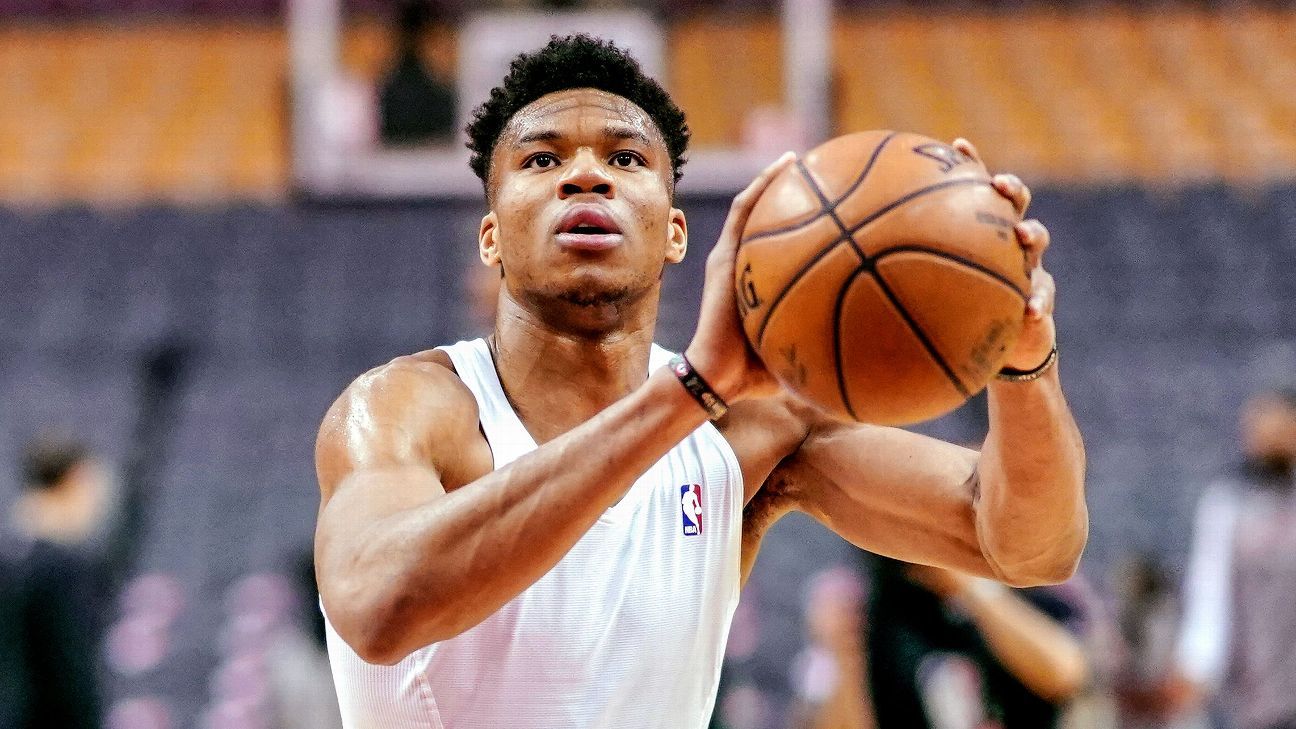IT IS 22 minutes before tipoff, precisely, and Giannis Antetokounmpo is on the move.
The Bucks’ do-everything forward springs up from the chair in front of his locker after a team meeting and walks barefoot from the locker room in Fiserv Forum into the training room, a path he takes before each home game.
“You know why I am here, Scottie,” Antetokounmpo says. Athletic trainer Scott Faust nods.
The superstar needs his sauce.
“I put hot sauce on my knees,” Antetokounmpo explains later. “It is not hot sauce. It is Icy Hot.”
From his careful body maintenance to his mental preparation — and even to his fashion choices — the NBA’s betting favorite to win MVP approaches his day with meticulous care. Indeed, every minute of Antetokounmpo’s game-day routine — which begins six hours before tipoff — is scripted.
Antetokounmpo’s eccentricities are a matter of efficiency, not superstition. Like Barack Obama and Steve Jobs before him, the 24-year-old All-Star aims to eliminate all unnecessary decisions and distractions. Instead of a blue suit or a black turtleneck, Antetokounmpo favors Nike Tech Fleece sweatsuits and has no interest in joining the NBA’s nightly pregame fashion shows.
“I just want to win,” Antetokounmpo says. “All that other stuff takes away from the game, and you just spend extra energy on looking good for five seconds. I don’t care about that. I just want to look good on the court. Get the win and go back home and lay on my couch and just watch game film. That’s it.”
Coming off six-straight 20+ point scoring games, Giannis goes through his pregame regimen in Miami.
🏀: @MiamiHEAT x @Bucks on @NBATV (8 pm/et)! pic.twitter.com/QihwT2Fk3d
— NBA (@NBA) March 15, 2019
THE BONES OF Antetokounmpo’s keep-it-simple routine were set in 2016-17, his breakout fourth season that saw him earn his first All-Star nod and most improved player honors.
First up, he explains one Saturday afternoon in March, is his nap, a top priority, as it is for many professional athletes. Antetokounmpo traces his nap dependency to his teenage years. As a 14-year-old in Greece, he remembers his father, Charles, insisting he nap between school dismissal at 2 p.m. and a 7 p.m. game.
Now, Antetokounmpo indulges after morning shootaround. The Greek Freak drives from the Bucks’ downtown practice facility to his home in River Hills, 15 minutes north. He tucks into his custom-sized bed at 1 p.m. and doesn’t emerge until 3:45. “If I don’t take a nap, I can’t play,” he says.
Once he’s recharged, Antetokounmpo departs for the arena by 4 p.m., allowing himself 30 minutes to stretch and do some soft tissue work with Laura Tietjen, his physical therapist. Then it’s time to hit the court for warm-ups, at 4:50. Assistant coach Ben Sullivan is already waiting to put Antetokounmpo through his carefully scripted shooting routine. When Antetokounmpo appears on the hardwood — usually in a skin-tight white tank top, orange shoes and sweatshorts — the two men don’t speak.
There is one important piece of his pregame routine that has little to do with performance. He admits it borders on superstition: as players pound fists and prepare to fight for the tip, Antetokounmpo jogs past the basket and into the first row of fans, slapping his chest once with each hand before lifting his right hand to the sky. Now, finally, he’s ready for tipoff.
After games, win or lose, Antetokounmpo invariably sits at his locker, icing his feet and pondering the night’s action in silence, before proceeding to shower and get dressed.
“His routine is over the top,” teammate Khris Middleton said. “I know where he is going to be every second before the game. When you see him not doing that, you realize something is wrong.”
Antetokounmpo’s routine is evidence of both his competitive hunger and his remarkable progress since entering the NBA as an unheralded teenager from Greece in 2013. During his six seasons, Antetokounmpo has dramatically improved his scoring, rebounding, passing, ballhandling and overall efficiency. He currently ranks first in player efficiency rating, third in scoring and sixth in rebounding leaguewide, while also serving as the best defensive player on the NBA’s stingiest defense. His rise has been aided by his development of professional habits and his willingness to absorb the guidance of Milwaukee’s coaching staff.
Case in point: his current shooting routine. The NBA’s best shooters, including Stephen Curry and James Harden, perform elaborate pregame routines that double as spectacles: midcourt shots; complicated, off-the-dribble combinations; and even one-legged free throws.
Antetokounmpo, however, is still a below-average outside shooter (25.6 percent from three-point range), and his routine is geared around strict fundamentals. Former Bucks assistant Sean Sweeney, a close confidante, has preached the importance of committing game shots to muscle memory, so Antetokounmpo sticks to simple, realistic attempts.
He works mostly from midrange. He usually catches passes on the move and shoots in one motion, focusing on his balance, clean footwork and maintaining good mechanics. More advanced shots might come down the road, but for now, he is working to get warm and confident rather than to dazzle onlookers.
“[His shooting routine] is all dialed in to a very specific, ‘This is what I have to do to get myself prepared to go out against the best players on the planet and dominate,'” Sullivan says.
Antetokounmpo closes his routine by shooting free throws. He takes several dribbles — sometimes four, sometimes eight — and pauses, cocking the ball up by his chin for several seconds before releasing. Afterward, he shakes hands with every person on the court, from Sullivan to the ball boys to the security guards, before heading back to the locker room for two 15-minute sessions in a NormaTec suit, which zips over Antetokounmpo’s legs and looks like an astronaut’s outfit. The machine hums as it squeezes his muscles to increase blood flow. He then has two 15-minute rounds of icing.
Save for his teammates and coaches, Antetokounmpo doesn’t speak to anyone. He routinely waves off reporters and tells autograph seekers that he will oblige after the game. Antetokounmpo used to attend chapel with his friend and teammate Thon Maker one hour before tipoff, a tradition that ended when the backup center was traded to the Detroit Pistons in February. Now, Milwaukee guard Pat Connaughton brings him a piece of paper with the lesson of the day scribbled on it.
There’s a good 3.5 minutes left of halftime, Ja Rule is mid-song and Giannis is already out shooting. pic.twitter.com/sPoyVnpI7x
— Malika Andrews (@malika_andrews) February 24, 2019
WHEN RAPPER JA RULE performed at center court during halftime of a February game, Antetokounmpo returned to the court for his standard shooting work, seemingly oblivious as “Always on Time” played around him. It reflected how Antetokounmpo’s adherence to schedule isn’t limited to his pregame routine.
By streamlining Antetokounmpo’s routine and loading it with skill development and health maintenance, Milwaukee’s coaches have sought to strike a compromise with their franchise player.
Antetokounmpo’s reputation as a workaholic who made regular late-night trips to the Cousins Center in St. Francis, Wisconsin, is well chronicled. After a loss or poor performance, a fuming Antetokounmpo would go to the old practice facility, where the team shared a swimming pool with elderly nuns, and re-create every made and missed shot. Back then, he wouldn’t even take the time to shower and change out of his uniform.
That unwillingness to give himself recovery time was a point of concern for Milwaukee coach Mike Budenholzer, who replaced Jason Kidd this season. The Bucks want to encourage Antetokounmpo’s intense work ethic — especially when it comes to improving his shot — but want to make sure he is not working himself to exhaustion.
Antetokounmpo hasn’t lost the urge to correct every mistake and smooth out every shaky shot. His focused pregame drills allow him to accomplish the most useful work, in a guided environment, without overly taxing him. Budenholzer has also scaled back Antetokounmpo’s minutes and given him nights off to nurse minor injuries. In his most controversial move, Budenholzer has instituted “lock-out” days — locking the team’s facilities to strongly encourage players to take the day off to recuperate.
“He is the prime example of who needs a lock-out day — who you literally have to put a lock on the door,” Budenholzer said of Antetokounmpo. “Giannis has grown a lot in being open to that and meeting us halfway. Or maybe 80 percent where Giannis is and 20 percent where we are.”
Perhaps the joke is on Budenholzer: The coach locked the facility, and Antetokounmpo built a home weight room with plans on eventually expanding it to a full gym. There, he owns the keys.
Antetokounmpo’s tendency to scrupulously script his day and control his own development bleeds into the offseason. While he says he approaches his summer with 50 percent of the intensity he has from October to June, close friends dispute that calculation. They estimate he dials it back only 10 percent in July and point out that he has toted a notebook to summer meetings with Kobe Bryant to track his next round of adjustments.
Antetokounmpo does make summer modifications to accommodate for relaxation and family time. Still, when approached about starring in “Space Jam 2” with LeBron James, Antetokounmpo declined. Being in the film would have required him to give up two weeks of private workouts to train with his fellow stars while making the movie, a total non-starter, given Antetokounmpo’s reclusive tendencies.
“I don’t like being Hollywood,” Antetokounmpo says. “I don’t like all this extra drama. I am just going to try to be me.”
All told, it takes Antetokounmpo some 20 minutes to detail his game-day preparation and offseason preferences. When he’s finished, he ticks off one final mental checklist to make sure he didn’t forget anything: “Nap. Shooting. Hot sauce.” He nods, confident he covered every base, then stretches his lengthy arms and pushes his chair away from the table. Then it hits him.
“Now, everyone is going to know about my routines and do the same,” Antetokounmpo says. “Or they are going to try to mess up my routines and sabotage me.”
Not if the Bucks’ attentive staffers have anything to say about it.
On a recent trip to Philadelphia, Antetokounmpo arrived in the trainer’s room seeking his hot sauce but was lost in thought. Faust, the trainer, looked up at him expectantly and asked, “Don’t you have anything to say to me?” Antetokounmpo’s eyes flashed, and he walked back out of the room before reappearing seconds later to deliver his customary greeting.
“You know why I am here, Scottie.”

